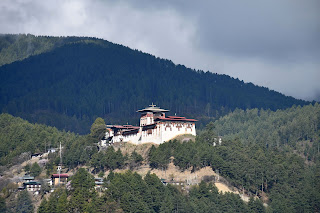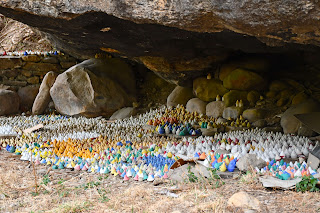Bhutan – Day 5: Jakar and Environs
On our way from Jakar this morning, we made two brief stops to take pictures of local sights. The first was Jakar Dzong, alleged by some to be the largest Dzong in Bhutan. The second was a rock by the village of Jalikhar, in which some recognise the shape of a vagina. Our first main stop, however, was Membartsho, also known as Burning Lake. The place holds a very special place in Bhutanese history, as it was in this lake that Pema Lingpa discovered his first terma: a teaching hidden by Guru Padmasambhava, held by Vajrayana Buddhists to be an incarnation of Buddha Amitabha.
The story goes like
this: Pema Lingpa was but an ordinary blacksmith of short and comical stature
until he had a dream urging him to the Tang Chuu River. Diving inside it, he discovered
a submerged temple, where he received a treasure chest from a one-eyed woman.
Upon returning to dry land, Pema Lingpa found that the treasure chest contained
Buddhist manuscripts. Despite his illiteracy, the blacksmith could read their
mysterious language.
Accounts of what
happened next vary. Some say that the local Penlop (governor) urged the
reluctant Pema Lingpa to go find more treasure in the lake. When he did, the
governor struck open the treasure chest and invited upon himself a great curse:
he was defeated by another equally ambitious ruler. Other accounts say that the
sceptical Penlop challenged Pema Lingpa to dive in again, which the holy man
did, emerging with his torch still alight. Upon witnessing this miracle, the
Penlop jumped in as well and was never seen again.
The site is now home
to a little temple honouring Pema Lingpa and Padmasambhava, as well as a quaint
wooden bridge. It crosses the rushing current at quite a height, as tall and
slippery rocks tower above the water. Consequently, the pilgrimage site has
seen a few fatal accidents over the years. Also remarkable is the number of tsa
tsas – little cones made of clay that believers bring to important religious
places.
We then drove a little
farther in the same direction, arriving in a pretty valley full of farms and
quaint streams. We walked through a muddy village, where we saw a water mill
and lots of purple flowers in full bloom. Climbing the hill, we were hailed
upon a few times. However, the weather refrained from pursuing any excesses,
and it actually became quite sunny once we clambered up to the Ogyen Choling
Palace and Museum. We sat by a stupa and drank tea while waiting for a school
trip to filter out of the building.
The Ogyen Choling
Palace and Museum is an interesting place. Overlooking the picturesque valley,
its four floors house exhibits on Bhutanese history and culture, which cover
diverse topics like festivals, agriculture, warfare, and so on. It is also insanely
cold, and all of us were deathly quiet by the time we reached the second floor,
hoping our guide would rush through the tour as fast as possible. Lunch warmed
us up but a little. After finishing, we bought some books written by Kunzang
Choden, the owner of the palace, who is a famous figure in Bhutan. At the age
of 70, she is still an energetic woman, and she seemed genuinely pleased to be
asked for an autograph.
Our penultimate stop
for the day was Ta Rimochen Lhakhang, a monastery founded by Pema Lingpa on a
spot visited by the legendary Guru Padmasambhava (incidentally, I just learned
that the word Lhakhang derives from the words “lha,” meaning “god,” and
“khang,” meaning “house.” The name Lhasa literally means “place of the gods”). Padmasambhava
had two wives with whom he practiced tantric meditation, and one of them was
able to turn into a tiger. It is said she left her mark on a striped rock in
front of the temple.
Finally, we stopped by the Pema Choling Nunnery. We came just in time for prayers, which the young nuns were reciting to the rapid beating of drums, the drone of massive horns, the clashing of cymbals, and the wailing of flutes. Not all the nuns were engaged in this exercise though. During our tour of the complex, we found some of the young women taking exams in religion and culture. We left just a minute before they had to hand in their papers.















































Comments
Post a Comment